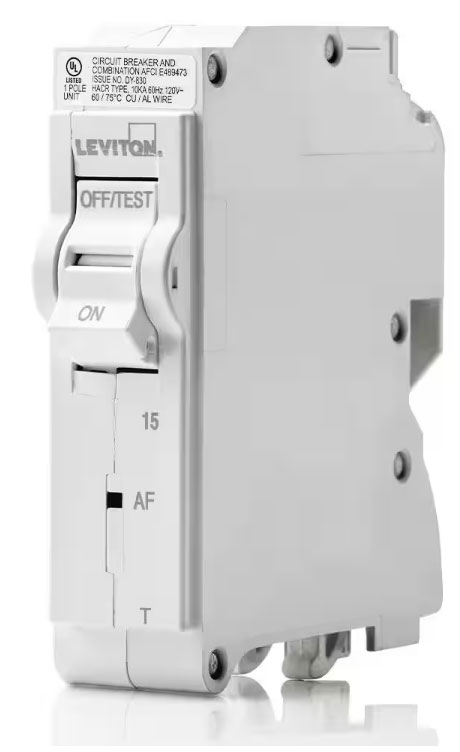A refrigerator hums in the kitchen, an iron sizzles in the laundry room, sprinkler timers tick on the back porch—and somewhere behind drywall, electricity is doing its invisible work. It’s a marvel until it isn’t. A frayed toaster cord can arc like a tiny welder; a splash of rinse water can leak current through a metal sink. Arc-fault circuit interrupters (AFCIs) and ground-fault circuit interrupters (GFCIs) were invented to stop those dangers in their tracks. Dual-function breakers put both shields in one switch—right inside the service panel—so homeowners never have to play “find the tripped outlet” again.
Two Codes, Two Mindsets
- NEC 210.8 (GFCI): Pinpoints locations—kitchens, bathrooms, laundry areas, garages, basements, exterior outlets—where the risk of shock from water is high.
- NEC 210.12 (AFCI): Targets whole environments—most finished living spaces—where damaged cords, rodent nicks or staple-pinched wires can arc and overheat.
Because those lists only partly overlap, electricians historically juggled two layers of protection: outlet-level GFCI devices for wet spots, breaker-level AFCIs for the branch circuits feeding them. Dual-function breakers marry the two, protecting every receptacle downstream from both shock and fire hazards.
Why Allstar Installs Them
- Reset once, not wander twice. When a dishwasher drip or nicked lamp cord trips protection, the homeowner heads to the panel—no kneeling behind the fridge or tearing apart a guest-bath vanity to press a tiny red button.
- Cleaner walls and counters. Remodelers can skip bulky GFCI receptacles on backsplashes or stone facades and use slim decorator outlets instead—keeping the design story intact.
- Future-proof compliance. As code committees add rooms to 210.8 and 210.12, a dual-function breaker is already ahead of the curve.
- Cost convergence. The price gap between single-purpose and dual-function breakers has narrowed; labor savings often tip the math in favor of the combo.
Where They Shine
|
Circuit Type |
Hazard Profile |
Why Dual Function Fits |
|
Kitchen small-appliance circuits |
Water + high load cords (mixers, air fryers) |
Panel reset avoids hidden GFCI behind fridge or built-in microwave. |
|
Laundry outlets |
Wet hands, metal machines, vibrating cords |
One breaker protects washer GFCI zone and AFCI-required laundry room. |
|
Outdoor receptacles & lighting |
Weather, extension cords, lawn tools |
Exterior outlets already need GFCI; AFCI adds cord-damage fire safety. |
|
Unfinished basements |
Damp concrete floors, portable heaters |
Code calls for both protections—combo breaker handles it elegantly. |
A Word on Nuisance Tripping
Sensitive electronics inside AFCI breakers “listen” for the telltale buzz of arcing. Certain motor-heavy loads—air compressors, pool pumps, older HVAC blowers—can mimic that signature and trip the breaker even when nothing is wrong. Allstar mitigates false alarms by:
- Placing mechanical equipment on dedicated, manufacturer-approved circuits.
- Using latest-generation breakers with improved filtering.
- Verifying neutral-ground separation and correct wiring torque.
If a client’s workshop compressor still chatters the breaker, we’ll test and, if needed, keep the compressor on a GFCI-only circuit while maintaining AFCI coverage elsewhere. Safety first, convenience close behind.
The Refrigerator Test
Imagine a built-in fridge tucked tight between custom cabinets. The outlet sits six inches off the floor, sealed by a toe-kick grille. If that receptacle were GFCI-only and it tripped, the homeowner would have to empty the fridge and slide 400 pounds forward just to press reset—assuming they know where the outlet is. Put the protection in a dual-function breaker and the fix is a panel visit that takes seconds and spares the groceries.
Is Your Panel Ready?
Most 200-amp service panels accept plug-on neutral dual-function breakers with no rewiring. Older panels may need pig-tail neutral versions or a bus kit upgrade. During a service call or remodel consultation, Allstar maps existing circuits, tags code-mandated locations, and flags motors that might call for separate treatment. Then we order brand-matched breakers—because mixed hardware can void listing approvals and your peace of mind.
Bottom Line
Dual-function breakers deliver two life-saving technologies in one elegant move of the thumb. They keep kitchens humming, laundry rooms spinning and back-porch string lights glowing—while the homeowner stays comfortably in front of the panel, not crawling behind appliances.
Electricity should be felt in the flick of a switch, not in the jolt of a shock or the heat of an electrical fire. With dual-function protection, Allstar Electrical makes sure you experience only the light.

